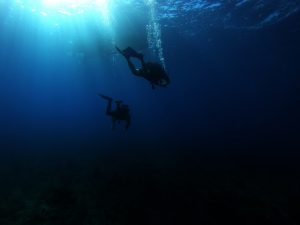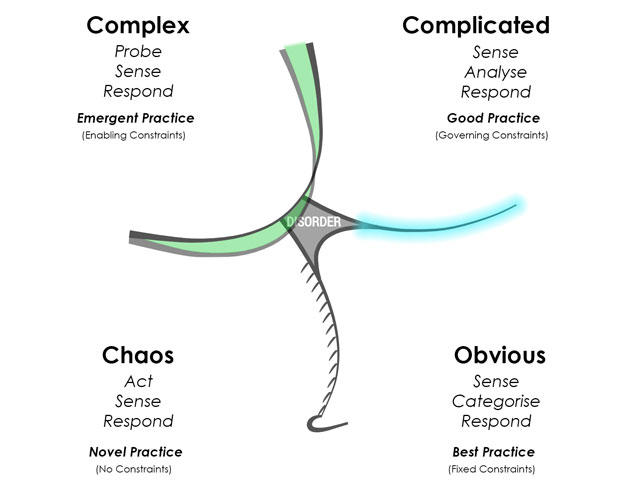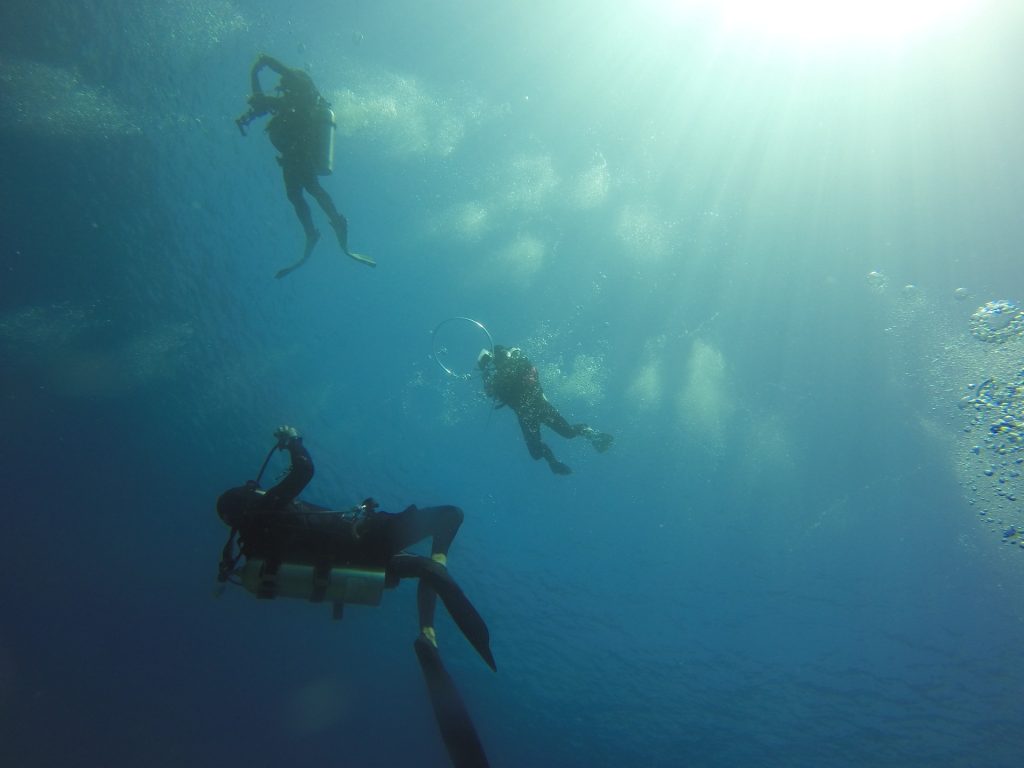Scuba Diving Part II: Unexpected Verification
Having now been diving again, and having (ironically) experienced a very interesting complication, I can add briefly to the previous post, Of Scuba Diving, Cynefin, & Value Delivery…
Something really sucked
My first dive was not a success. The delivery of the value was, well. Sub-optimal isn’t quite the word. I took an unknown quantity with me (a technical diving wing and plate) as part of my own gear, including a new regulator setup. This is designed to be better than rental gear, relaxing you and improving all aspects of the dive. To my shock, and horror (this is a bad thing underwater at ~24m), my air was going down as if I had a leak. 180 bar in 28 minutes is not normal!
I’ve never seen anything like it. This was using low weight (which was also odd, I should dive with 2kg and ended up needing a lot more to even descend on the first dive) and using my breath for buoyancy, not heaving like a runner on land as many people tend to when they start diving. I know it had been a while, but… this wasn’t normal.
Luckily feedback is constant with diving, especially if you wish to continue breathing, so I had plenty of time to consider options and causes. I tried upgrading to nitrox at EAN32 and a 15l tank for the next dive… I managed 37 minutes at max depth of 29m.
For those who don’t dive, this is ridiculous. A 32% oxygen/nitrogen mix should give far more bottom time than standard air, yet by the time we surfaced I was at an incredibly (and almost dangerously) low 20 bar. You should always plan to surface with 50 as a reserve, and I’ve never not done so before. I was sucking incredible quantities of air, despite some experience and careful usage. Admittedly, it had been a year since my last dive, which is quite long, but this was still way out of projection.
So what happened? Why was I suddenly emulating the finest vacuum cleaner? And how is this related to my previous article?
Context Matters
Firstly, I was dealing with a set of unknowns. I’d never used this rig before here – only in fresh water over a dry suit, with the guy who sold it to me as a “huge improvement for trim and diving”. I’m not a tech diver; I don’t have the rig, the gear, the training, or the cold water diving experience to utilise it, so relying on his expert advice was in retrospect more about him selling the gear and less about what was right for me as a more tropical diver.
Rule # 1 – ALWAYS test dive gear and/or consider context when possible! I didn’t, and this is how we learn. Long term, there is no failure, only feedback.
Immediate differences were apparent: the water was salt. The temperature was higher. I’d never used this getup before. It was a new dive site. It was significantly less comfortable than over a drysuit in a lake. I’d only had 2 hour’s sleep after travelling for around 10 hours (NOT advisable!) and was fatigued and stressed. There were multiple unknowns, and they did not match my projections. I only realised this mid-first dive.
Does this sound familiar in business? A plan gets set up, it’s worked before, so no one checks this time… it’s only mid-rollout that it becomes apparent that things are not as they should be, and panic and scrabble ensues whilst the stakeholders are assured everything is under control. The perception of value delivery becomes more important than the reality.
What you do must be gauged against the current situation, not estimated solely against the past, if you wish to accurately ascertain the data and act accordingly. I was out of context, and until I considered the context, I could not begin to resolve the issues.
Constraints needed identifying
Secondly, I had misjudged the constraints on the dives. What was planned and tested in dive prep – hypothetically, practically in different context, and obvious or complicated! – resolved on application to actually be in disorder. This is what Dave Snowden talks about when he mentions the danger of assuming a domain from the start, and acting on that assumption. To be fair, given prior experience, it should have been clear, but I hadn’t factored in new constraints which were absent or different from other dives (and, as above, context is key).
A dual-bladdered tech wing with drag and combined 90lbs of lift is not suited to my recreational diving practices. This I now know. It is far too buoyant despite a steel back plate; it changed the limits on air and usage, and the trim was ok, but not vastly improved. It was uncomfortable, stressful to don, and stressful in the water.
I didn’t test; I didn’t cover the new context to understand how the constraints could affect me differently. Once the dive was under way, and I realised my remaining air was dropping like a lead weight, I realised the situation was not only disordered instead of complicated, and resolving into complexity, but in real danger of failure into crisis.
Had I not been more aware, and carried out the obvious/complicated steps and constant checks during the dive (real-time monitoring is key in complexity probes!), I would have – without doubt – considered myself in the ordered domains and likely consequently tipped over the cliff-edge into complacency-induced catastrophic failure (read this as: NEVER fail to regularly check your air on a dive!).
In the end, those constraints – which I understood and knew about, but had not redefined contextually – limited and severely disrupted my dive (and the dive of some of those around me). Some constraints don’t change for diving; and instead of working with them, I ran up against them being fixed and governing my dive.
Hand in hand with this went Practice. Best practice was not achievable; Good practice was adhered to where I could, but it became very clear very quickly I was in the realm of emergent practice.
Complexity encroached…
…and came dangerously close to chaos. This can happen at any time because, as mentioned previously, dives contain a number of areas by nature out of our control.
My situation was still safe-to-fail; even had I hit zero gas, both an instructor and divemaster were on hand to give extra air as we ascended. Plenty for the safety stop, which is a requirement (in complication). Remember Stop-Breath-Think/Probe-Analyse-Respond; I had multiple options to consider to end the dive safely, but nevertheless, with the stress and confusion of what was happening, I could see the pale edge of panic and understand how even experienced and calm people could cross into it.
This point is where a lot of divers WILL panic, despite the safe-to-fail alternatives, and when you lose reason you are in serious danger, especially in a situation that requires reason from the outset (we’re not designed to breath underwater, so everything must rely on the application of the reason that led to the setup and implementation of the circumstances. Our instincts cannot and do not help us in this situation).
Crisis management was visible, and I relaxed and took stock so I could avoid it. If you don’t do this when diving, you are in real trouble. The trouble was, this detracted from the dive and the goal, which I achieved, but would have rather spent longer experiencing!
Analysis
I decided to consider what had happened, and grouped data by possible impact. My new regulator had a venturi switch (which I’d never had before – it governs pressurised airflow through a system), which I forgot to switch on. Perhaps that had an effect? I hadn’t dived for a while. Perhaps that had an effect? What data could I look at?
I pondered what had changed since my last tropical dives, and decided that rather than the ever-tempting process of categorisation, I would allow new understanding to emerge from the data.
So I tested different configurations. Gas, size, weight, etc, all in the correct medium (salt water, which has different buoyan). The regulator was discounted as an issue (brand new and very efficient, and unless it’s leaking it turns out it has very little effect on consumption).
I tested ideas by referring to multiple instructors at once, people who do this every day and have different gear and requirements, both men and women (air usage is heavier in general for men). I ran distributed brainspace probes for possible issues, and many possibilities were thrown up; at least one was known to be naïve (I asked other divers and even students what they thought). The multiple experts knew the dives and how the baseline metrics within a given scope should work.
We had a lot of different ideas, and what came out were three main points:
Context was key. The environment and what others were successfully using needed to be a baseline. The elimination of possibilities such as the new regulator making that much of a difference based on expert advice.
Differences to last successful contextual dive were crucial. (All rental equipment! This time, my own gear, but having the diametrically opposite effect than expected).
Elimination of differences, one by one with feedback after each, to see what happened. (Again, I had suspicions).
Finally, I tested states of mind and methods I knew had worked in the past, and evaluated why they might not work here. I got some sleep; I relaxed; I still found issues.
What was left after multiple probes, concurrent mindspace sharing with experts, my own gut feeling, and multiple dives with different setup appeared to be one key factor remaining:
The tech wing and plate.
Resolutions
We couldn’t ignore the data that had emerged from our discussions and tests; there was little left apart from a significant change in my physiology, which was not a great consideration to contemplate.
So for the next dive, I hired a regular bcd (standard dive jacket), connected it to a normal tank of air (baseline against the other divers again), and used my regulator.
Three of us dived. I came up with roughly the same air as the divemaster, after a relaxed dive with near-perfect trim (I trim weirdly, more on that another time) – 50 bar after 39 minutes, max depth of 24m.
Let’s put that in perspective: an EAN32 dive with 15l lasted 37 minutes and nearly ended in crisis; an air dive with 10l lasted exactly as planned, in line with the divemaster in fact, and I was not the one who ended the dive; my buddy was. I was clam, collected, enjoyed the dive, and found myself exactly back where I remembered being; the peak of efficiency, trim, value delivery, and experience. The difference was astounding; all my anxiety and fear had vanished.
(The relief you find when it’s not actually something intrinsically wrong with you is… profound!).
What did I do here with regards to Cynefin?
I recognised that I was in a complex, unexpected scenario; I probed, analysed, and then changed significant constraints based on context.
From this point on, my dives transitioned back into complication, and progressed as planned.
How directly analogous is this to business mentioned in the last blog post, and how a company will make assumptions, often untested, and then find themselves fighting to mitigate or avoid disaster, and still deliver any value? Often changing a constraint in complexity delivers a profound change – and delivering value is, ultimately, the primary goal (outside staying safe both long and short term).
Conclusion
So it turns out that my suspicions were correct, and heavily influenced by complexity – not only the new site, the new experience, the time since last contextual dive, and the new gear, but also anthro-complex considerations such as stress, fatigue, and alarm/stress induced when expectations were not met, all contributed. It was my new, context-untested gear I had made assumptions about, but all these things had an impact. This was not an obvious or complicated resolution.
I still achieved my goals despite it; I dived with Thresher Sharks, and got some amazing footage (I might even pop some on here).
I wasn’t expecting to have to apply elements of the last post so soon, but I’m glad I did, in a way; it validates the comparisons.
Safe coherence out there!



